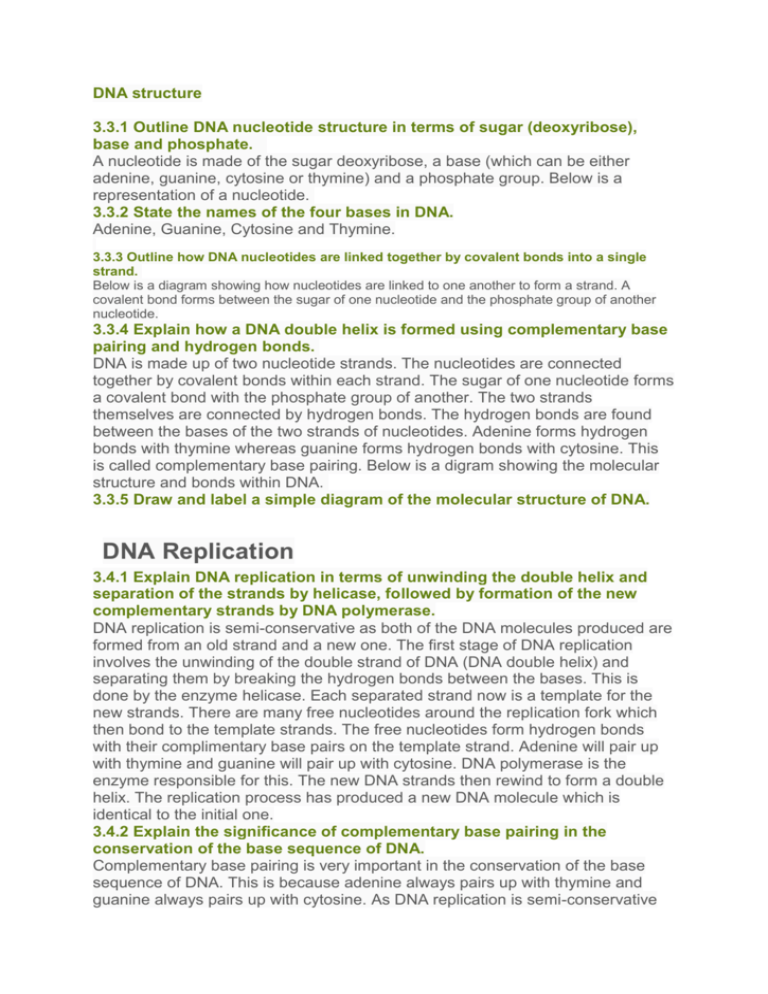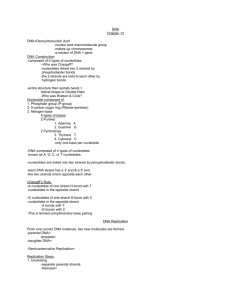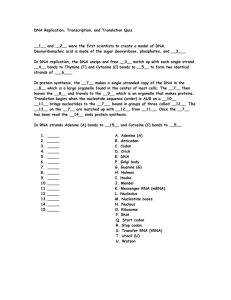DNA structure - LancyBiologyIB
advertisement

DNA structure 3.3.1 Outline DNA nucleotide structure in terms of sugar (deoxyribose), base and phosphate. A nucleotide is made of the sugar deoxyribose, a base (which can be either adenine, guanine, cytosine or thymine) and a phosphate group. Below is a representation of a nucleotide. 3.3.2 State the names of the four bases in DNA. Adenine, Guanine, Cytosine and Thymine. 3.3.3 Outline how DNA nucleotides are linked together by covalent bonds into a single strand. Below is a diagram showing how nucleotides are linked to one another to form a strand. A covalent bond forms between the sugar of one nucleotide and the phosphate group of another nucleotide. 3.3.4 Explain how a DNA double helix is formed using complementary base pairing and hydrogen bonds. DNA is made up of two nucleotide strands. The nucleotides are connected together by covalent bonds within each strand. The sugar of one nucleotide forms a covalent bond with the phosphate group of another. The two strands themselves are connected by hydrogen bonds. The hydrogen bonds are found between the bases of the two strands of nucleotides. Adenine forms hydrogen bonds with thymine whereas guanine forms hydrogen bonds with cytosine. This is called complementary base pairing. Below is a digram showing the molecular structure and bonds within DNA. 3.3.5 Draw and label a simple diagram of the molecular structure of DNA. DNA Replication 3.4.1 Explain DNA replication in terms of unwinding the double helix and separation of the strands by helicase, followed by formation of the new complementary strands by DNA polymerase. DNA replication is semi-conservative as both of the DNA molecules produced are formed from an old strand and a new one. The first stage of DNA replication involves the unwinding of the double strand of DNA (DNA double helix) and separating them by breaking the hydrogen bonds between the bases. This is done by the enzyme helicase. Each separated strand now is a template for the new strands. There are many free nucleotides around the replication fork which then bond to the template strands. The free nucleotides form hydrogen bonds with their complimentary base pairs on the template strand. Adenine will pair up with thymine and guanine will pair up with cytosine. DNA polymerase is the enzyme responsible for this. The new DNA strands then rewind to form a double helix. The replication process has produced a new DNA molecule which is identical to the initial one. 3.4.2 Explain the significance of complementary base pairing in the conservation of the base sequence of DNA. Complementary base pairing is very important in the conservation of the base sequence of DNA. This is because adenine always pairs up with thymine and guanine always pairs up with cytosine. As DNA replication is semi-conservative (one old strand an d one new strand make up the new DNA molecules), this complementary base pairing allows the two DNA molecules to be identical to each other as they have the same base sequence. The new strands formed are complementary to their template strands but also identical to the other template. Therefore, complementary base pairing has a big role in the conservation of the base sequence of DNA. 3.4.3 State that DNA replication is semi-conservative. DNA replication is semi-conservative. DNA Structure HL 7.1.1 Describe the structure of DNA, including the antiparallel strands, 3'-5' linkages and hydrogen bonding between purines and pyrimidines. DNA is made up of two strands. At one end of each strand there is a phosphate group attached to the carbon atom number 5 of the deoxyribose (this indicates the 5' terminal) and at the other end of each strand is a hydroxyl group attached to the carbon atom number 3 of the deoxyribose (this indicates the 3' terminal). The strands run in opposite directions and so we say that they are antiparallel. One strand runs in a 5'-3' direction and the other runs in a 3'-5' direction. Adjacent nucleotides are attached together via a bond between the phosphate group of one nucleotide and the carbon atom number 3 of the deoxyribose of the other nucleotide. The bases of each strand link together via hydrogen bonds. Adenine and Guanine are purines as they have two rings in their molecular structure. Thymine and Cytosine are pyrimidines as they only have one ring in their molecular structure. A purine will link with a pyrimidine. Adenine and thymine link together by forming two hydrogen bonds while Guanine and cytosine link together by forming 3 hydrogen bonds. 7.1.2 Outline the structure of nucleosomes. Nucleosomes consiste of DNA wrapped around eight histone proteins and held together by another histone protein. 7.1.3 State that nucleosomes help to supercoil chromosomes and help to regulate transcription. Nucleosomes help to supercoil chromosomes and help regulate transcription. 7.1.4 Distinguish between unique or single-copy genes and highly repetitive sequences in nuclear DNA. Not all of the base sequences in DNA are translated. Highly repetitive base sequences are not translated. They consist of sequences of between 5 and 300 bases that may be repeated up to 10 000 times. They constitute 5-45% of eukaryotic DNA. Single-copy genes or unique genes are translated and constitute a surprisingly small proportion of eukaryotic DNA. 7.1.5 State that eukaryotic genes can contain exons and introns. Eukaryotic genes can contain exons and introns. DNA replication HL 7.2.1 State that DNA replication occurs in a 5'→3' direction. DNA replication occurs in a 5'→3' direction. 7.2.2 Explain the process of DNA replication in prokaryotes, including the role of enzymes (helicase, DNA polymerase, RNA primase and DNA ligase), Okazaki fragments and deoxynucleoside triphosphate. The first stage of DNA replication in prokaryotes is the uncoiling of the DNA double helix by the enzyme helicase. Helicase separates the DNA into two template strands. RNA primase then adds a short sequence of RNA to the template strands. This short sequence of RNA is a primer which allows DNA polymerase III to bind to the strands and start the replication process. Once this is done, DNA polymerase III adds nucleotides to each template strand in a 5'→3' direction. The nucleotides have 3 phosphate groups and are called deoxyribonucleoside triphosphates. Two of these phosphate groups break off during the replication process to release energy. Since the strands are antiparallel (the two strands have their 5' end and 3' end in opposite sides) and replication can only occur in a 5'→3' direction, one of the strands will be replicated in the same direction as the replication fork and the other will be replicated in the opposite direction of the replication fork. This means that one of the strands is synthesised in a continuous manner (named the leading strand) while the other one is synthesised in fragments (named the lagging strand). The leading strand only needs one primer while the lagging strand needs quite a few as it is formed in fragments. These fragments are called Okazaki fragments. DNA polymerase I will remove the RNA primers and replace these with DNA. The enzyme DNA ligase then joins the Okazaki fragments together to form a continuous strand. Summary: 1. Helicase uncoils the DNA 2. RNA primase adds short sequences of RNA to both strands (the primer) 3. The primer allows DNA polymerase III to bind and start replication 4. DNA polymerase III adds nucleotides to each template strand in a 5'→3' direction 5. These nucleotides are initially deoxyribonucleoside triphosphates but they lose two phosphate groups during the replication process to release energy 6. One strand is replicated in a continuous manner in the same direction as the replication fork (leading strand) 7. The other strand is replicated in fragments (Okazaki fragments) in the opposite direction (lagging strand) 8. DNA polymerase I removes the RNA primers and replaces them with DNA 9. DNA ligase then joins the Okazaki fragments together to form a continuous strand 7.2.3 State that DNA replication is initiated at many points in eukaryotic chromosomes. DNA replication is initiated at many points in eukaryotic chromosomes.






